Peut-on faire de la musculation après 50 ans ? Contrairement à certaines idées reçues, la réponse est oui ! Et c’est même largement recommandé, tant les bienfaits de l’activité physique sont nombreux.
Certes, après un certain âge, muscler son corps devient de plus en plus difficile. Mais avec un bon programme de fitness et une alimentation adaptée, il reste tout à fait possible de sculpter vos pectoraux, vos abdominaux, vos biceps, vos triceps ou vos fessiers. Grâce à ces quelques conseils, vous allez vous refaire une jeunesse en un rien de temps !
Faire de la musculation après 50 ans, en bref :
- Se muscler après 50 ans est recommandé pour la santé.
- L’entraînement en résistance est essentiel pour favoriser l’hypertrophie et renforcer les articulations.
- Un programme équilibré doit solliciter l’ensemble du corps.
- Associer la musculation à d’autres activités physiques (cardio, marche, yoga, etc.) améliore la condition physique.
- L’alimentation joue un rôle clé avec un apport suffisant en protéines.
- La muscu permet de lutter contre la sarcopénie et d’améliorer la force.
Sommaire
Comment choisir un programme de musculation après 50 ans ?
Que vous cherchiez à prendre de la masse ou à perdre du poids, ces quelques conseils vous permettront d’atteindre votre objectif.
Intégrez de la résistance à vos entraînements
Se muscler à 50 ans implique nécessairement de suivre un entraînement de musculation avec de la résistance. Mais qu’est-ce que cela signifie exactement ?
L’objectif est d’appliquer une contrainte sur vos muscles pour engendrer des micro lésions dans les fibres musculaires. Ces fibres vont ensuite se reconstruire dans les jours suivant la séance, et grossir par la même occasion.
C’est le principe de l’hypertrophie. Et cela vaut aussi bien pour le bas que pour le haut du corps.
Il existe plusieurs manières de mettre vos muscles sous tension :
- Au poids du corps sur certains exercices (pompes, tractions, squat, etc.)
- Avec des élastiques de résistance
- En utilisant des barres et des haltères
- En s’entraînant sur des machines guidées, pour une plus grande stabilité
L’entraînement en résistance favorise aussi le renforcement des articulations. Attention toutefois à y aller de manière progressive.
D’après une étude réalisée en 2021, ce type d’effort est essentiel pour contrer la sarcopénie, cette perte progressive de masse et de force musculaires liée à l’âge. Selon le Centre Hospitalier Universitaire de Bordeaux, dès 50 ans, la masse et la force musculaires diminuent de manière significative, augmentant ainsi le risque de chutes et de fractures.
Les débutants privilégieront les exercices au poids du corps ou avec des bandes élastiques, avant de commencer à travailler avec des charges légères. Car oui, il est possible de débuter la musculation après 50 ans.
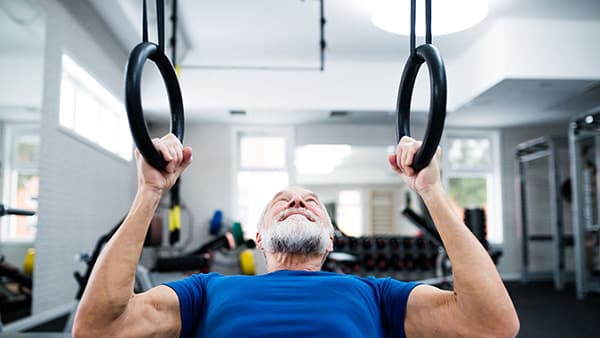
De leur côté, les pratiquants ayant déjà de l’expérience pourront directement pousser de la fonte, en veillant à ce que les charges soient adaptées.
Dans les deux cas, n’hésitez pas à faire appel à un coach sportif qui saura vous accompagner.
Nul besoin de posséder des kilos de matériel pour progresser. En salle de sport ou à la maison, vous pourrez perdre du gras et vous muscler avec quelques équipements bien choisis.
Travaillez l’ensemble du corps
Pour amorcer une transformation physique à 50 ans, il est essentiel de solliciter l’ensemble de vos muscles, du haut et du bas du corps.
Adopter un programme d’entraînement équilibré est la clé pour votre développement musculaire.
Optez pour des exercices de base (développé couché, développé militaire, squat, etc.) pour solliciter les grands groupes musculaires, puis complétez chaque séance avec des exercices d’isolation.

DÉCOUVREZ TOUS MES PROGRAMMES
En procédant ainsi, vous aurez suffisamment de temps de repos entre chaque séance de musculation pour bien récupérer.
Rappelez-vous, c’est lorsque vos muscles se reposent qu’ils se construisent.
Concentrez-vous sur votre mobilité et votre force. Inutile de vouloir pousser ou soulever lourd. Il est largement préférable d’utiliser des poids plus légers, mais en soignant la technique d’exécution. Vous éviterez ainsi des blessures inutiles (mal de dos, douleurs aux articulations, etc.).
Votre entraînement ne doit pas dépasser 1 heure.
Faites des activités sportives complémentaires
Pour une personne qui souhaite se remettre au sport à 50 ans, ou qui désire se maintenir en forme, il peut être intéressant de compléter la pratique de la musculation par d’autres activités physiques.
Le plus efficace sera toujours de varier les activités afin de mobiliser tous les groupes musculaires et de rester en bonne santé. Privilégiez autant que possible celles qui ont un impact moindre sur les articulations.
Ainsi, associer du renforcement musculaire avec des exercices de cardio est un excellent moyen de maintenir votre système cardio-vasculaire. Répartissez, par exemple, 3 séances de musculation et 1 autre type de séance sur la semaine.
Voici quelques idées d’activités complémentaires :
- La gym douce : associant des mouvements de respiration, d’équilibre et de cardio, cette méthode vise à renforcer vos muscles profonds et à améliorer votre posture.
- La méthode Pilates ou le yoga : pour ceux qui souhaitent renforcer leur ceinture abdominale en douceur, mais efficacement, c’est l’activité à choisir. Elle allie remise en forme, stretching et relaxation en tonifiant tous les muscles de votre corps. Vous gagnerez également en souplesse et en mobilité.
- La marche : les bienfaits de la marche sont nombreux. Cette activité participe à la réduction des douleurs articulaires et à la tonification du corps.
- L’aquagym : si vous souffrez d’arthrose, d’arthrite ou de douleurs musculaires, c’est le sport qui vous conviendra en premier lieu. En effet, l’eau agit comme une aide précieuse pour accompagner chacun de vos mouvements. Elle se pratique généralement en en cours collectifs.
- La corde à sauter : si vous ne souffrez pas de vos articulations, ce sport est l’un des plus complets qui existe. Il sollicite aussi bien les membres inférieurs que supérieurs, augmente votre équilibre, améliore votre souffle et aide à brûler des calories.
Écoutez votre corps
Un mouvement vous fait mal ? Vous ne vous sentez pas à l’aise sur un exercice ?
Heureusement, il existe de multiples variantes pour cibler un muscle.
Votre ressenti compte. Il est même plus important que tout le reste. En cas de besoin, faites appel à un professionnel du coaching qui pourra vous conseiller sur les meilleurs exercices à faire, en tenant compte de vos besoins et de vos antécédents.
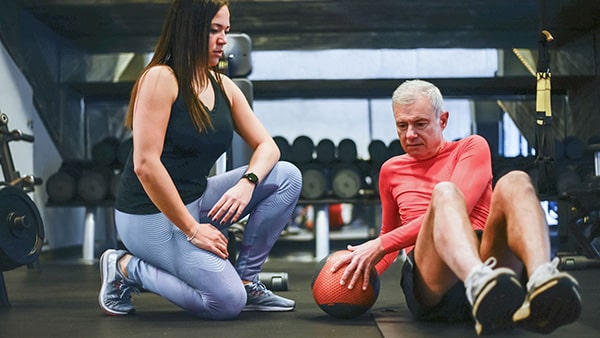
Pensez aussi à bien vous échauffer avant chaque entraînement, au moins durant 15 minutes. Vous limiterez le risque de vous blesser. Cela est vrai à 20 ans, mais encore plus à 50 ans lorsque les articulations (poignets, coudes, hanches, genoux, etc.) commencent à souffrir.
Enfin, avant de vous lancer, n’hésitez pas à consulter l’avis d’un médecin.
Exemple de programme de musculation pour un homme après 50 ans
Voici un exemple de programme d’entraînement physique pour une personne de 50 ans, sur la base de 4 séances par semaine :
- Séance 1 : pectoraux et épaules
- Séance 2 : 1 heure d’activité cardio (marche, natation, cyclisme, etc.)
- Séance 3 : 30 à 45 minutes de renforcement postural (yoga, pilates, etc.) ou de stretching
- Séance 4 : jambes
- Séance 5 : dos, biceps et triceps
| Jour | Activité | Durée | Type d’effort |
|---|---|---|---|
| Lundi | Séance pectoraux et épaules | 45 min | Renforcement musculaire |
| Mardi | Marche rapide, vélo ou natation | 60 min | Endurance douce |
| Mercredi | Renforcement postural ou stretching | 30 min | Récupération active |
| Jeudi | Repos complet | – | – |
| Vendredi | Séance jambes | 60 min | Renforcement musculaire |
| Samedi | Séance dos, biceps et triceps | 45 min | Renforcement musculaire |
| Dimanche | Repos complet | – | – |
Vous pouvez le faire au poids du corps et avec des bandes élastiques, ou avec des charges dans une salle de musculation. Voici le contenu de chacune des séances musculation.
Séance pectoraux et épaules
| Exercice | Nombre de répétitions |
|---|---|
| Pompes | 4 x 10 répétitions |
| Développé couché | 3 x 8 répétitions |
| Développé militaire | 4 x 10 répétitions |
| Élévations latérales | 3 x 8 répétitions |
| Élévations frontales | 3 x 8 répétitions |
Séance jambes
| Exercice | Nombre de répétitions |
|---|---|
| Squat | 4 x 10 répétitions |
| Deadlift sur une jambe | 3 x 8 répétitions |
| Fentes marchées | 3 x 10 répétitions |
| Extensions des mollets debout | 4 x 12 répétitions |
| Élévations de bassin | 4 x 10 répétitions |
| Abdominaux (crunchs) | 4 x 10 répétitions |
Séance dos, biceps et triceps
| Exercice | Nombre de répétitions |
|---|---|
| Tirage horizontal | 4 x 10 répétitions |
| Rowing buste penché | 4 x 10 répétitions |
| Curls biceps | 4 x 10 répétitions |
| Curls prise marteau | 4 x 10 répétitions |
| Extensions au-dessus de la tête | 4 x 12 répétitions |
Le rôle de l’alimentation pour les seniors
Une nutrition riche en protéines
En plus de l’entraînement, une prise de muscle repose grandement sur la qualité de l’alimentation.
Manger correctement vous permettra d’apporter à votre corps tout ce dont il a besoin pour fonctionner pleinement.
À ce titre, vous devez veiller à respecter votre total calorique. Ce dernier est à ajuster selon que vous souhaitiez perdre du gras ou en prendre.
Il en est de même pour la répartition de vos macronutriments (glucides, protéines et lipides)..
J’attire notamment votre attention sur le rôle des protéines. Une étude de 2017, menée par une équipe de l’université McGill au Canada et publiée dans l’American Journal of Clinical Nutrition, a ainsi constaté que les quinquagénaires (et plus) ne consommaient des protéines qu’au moment du dîner.
Or, ce macronutriment est fondamental, car il participe au maintien de la masse musculaire, et de l’autonomie par la même occasion. Les chercheurs ont donc conclu en invitant les plus de 50 ans à consommer des protéines à tous les repas (matin, midi et soir).
De plus, favorisez les aliments naturels et délaissez au maximum les produits ultra transformés, riches en sucre et en matières grasses. Voici des aliments que vous pouvez utiliser au quotidien :
- La viande blanche (poulet, dinde, etc.)
- Le poisson
- Les oeufs
- Les fruits et légumes
- Les légumineuses
- Les produits à base de céréales complètes
- Les oléagineux
Enfin, ne négligez pas l’hydratation, indispensable au soutien de la construction musculaire.
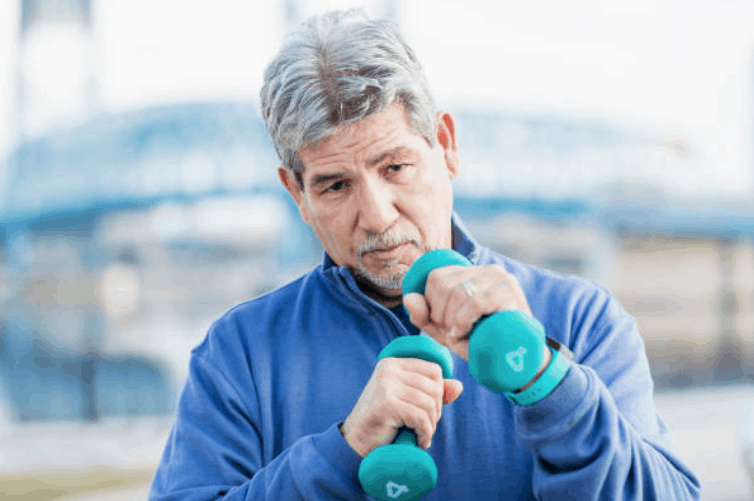
Quels compléments alimentaires après 50 ans ?
Passé un certain âge, pour rester en bonne santé, il peut être intéressant de se supplémenter en vitamines et en minéraux.
Gardez en tête que les compléments n’ont pour seule vocation que de venir compléter des besoins non couverts par votre alimentation solide.
Pourquoi ne pas également vous tourner vers la spiruline, une algue aux nombreuses vertus, capable de freiner les effets du vieillissement ?
Enfin, une question qui revient souvent chez mes élèves est : Peut-on prendre de la whey après 50 ans ?
La réponse est oui, bien sûr. La protéine en poudre est un excellent moyen d’assurer un apport suffisant en protéines jour après jour, surtout si vous avez du mal à y parvenir avec vos repas habituels.
Les bienfaits de la musculation
Le corps subit de nombreux changements au cours de la vie. C’est notamment le cas lorsqu’on vieillit. Le mode de vie change également, car les personnes âgées ont tendance à être plus sédentaires.

Il convient donc d’adapter sa nutrition, et de se préoccuper davantage de sa condition physique. En effet, plus vous devenez vieux, plus vous risquez de souffrir de sarcopénie, une perte de masse musculaire naturelle pouvant rendre difficile certains gestes de la vie quotidienne.
Ce changement résulte d’une modification du taux de vos hormones, notamment de la baisse de la testostérone. Cela contribue à atrophier les muscles profonds du corps et, dans certains cas, à accumuler de la graisse au niveau de la sangle abdominale. Il faut donc lutter pour maintenir son tonus musculaire.
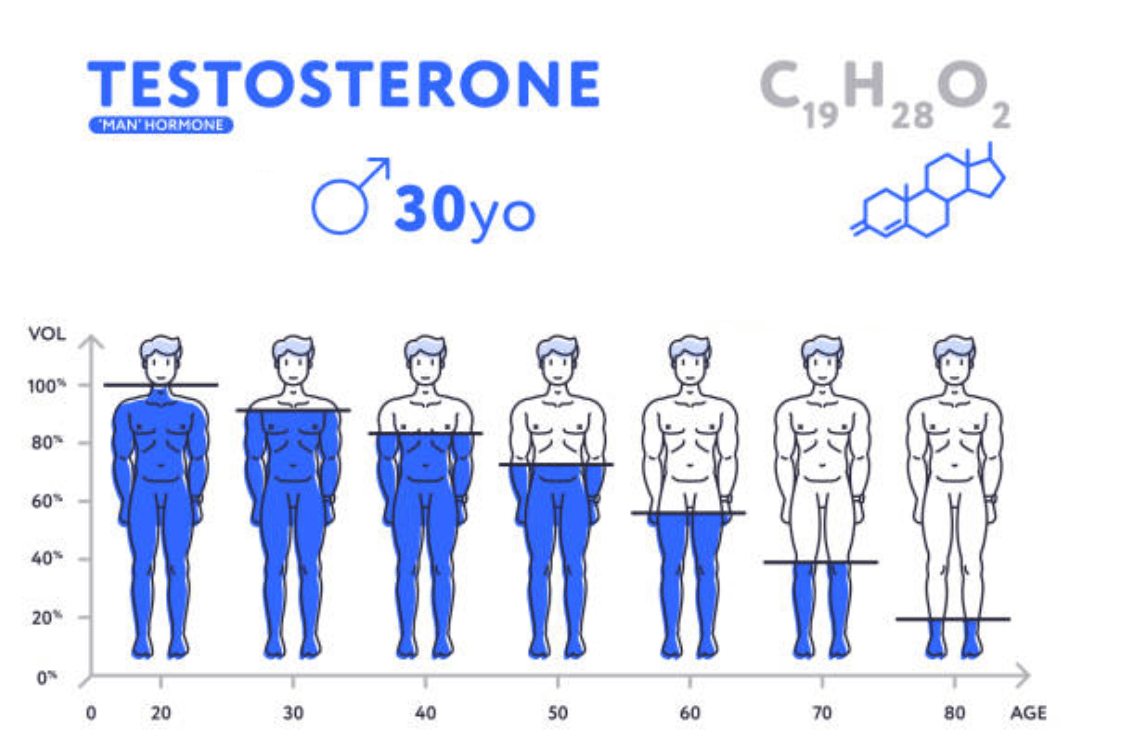
J’ajoute qu’il est plus difficile de construire du muscle, car le vieillissement du corps empêche le bon déroulement de la synthèse des protéines.
Or, plus vous avez de masse musculaire, plus votre corps va brûler des calories, ce qui est très important pour éviter d’accumuler trop de graisse corporelle. C’est cette combinaison d’effets qui fait que le vieillissement est souvent associé à une prise de poids.
Si vous ne faites pas des exercices de musculation régulièrement, et que vous ne changez pas votre alimentation, alors vous prendrez inévitablement de la masse grasse.
En résumé, faire de la musculation après 50 ans est idéal pour :
- Brûler des calories
- Réduire le risque cardio-vasculaire
- Améliorer les fonctions cognitives
- Libérer les hormones du bien-être
- Diminuer le stress et l’anxiété
- Améliorer le souffle et l’endurance
- Développer la force motrice
- Rajeunir le corps
Peut-on réellement se muscler après 50 ans ?
Entre la baisse de la testostérone et la fonte musculaire, est-il réellement possible de gagner du muscle passé 50 ans ?
Bien sûr ! Il est possible de se muscler, peu importe votre âge ! Que vous choisissiez de vous entraîner en salle de musculation ou à la maison, vous verrez votre corps changer en quelques mois.
N’oubliez pas que votre programme de muscu doit être associé à une nutrition de qualité. Avec une bonne dose de volonté, vous avez toutes les cartes en main pour déplacer des montagnes. La preuve avec ces 2 élèves de la team qui ont atteint des physiques remarquables à plus de 50 ans.
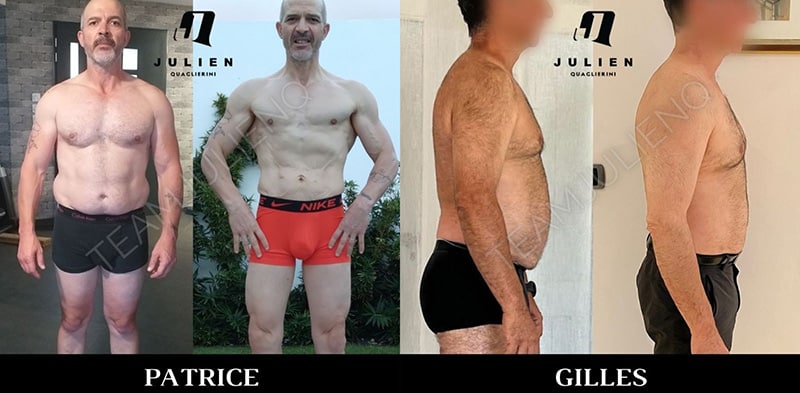
En revanche, ce serait mentir de vous dire que cela va se faire en quelques semaines. Si cela est le cas pour un pratiquant de musculation de 20 à 40 ans, il vous faudra plus de temps et de patience à plus de 50 ans.
Quoi qu’il en soit, il est vital de rester actif le plus longtemps possible. Pour cela, choisissez des exercices adaptés et avancez à votre rythme.
Si vous faites appel à un coach, ce dernier vous guidera tout au long du processus de remise en forme. J’ai justement conçu un accompagnement dédié aux hommes de plus de 40 ans désireux de retrouver leur vitalité. : le programme Total Reborn.

Conclusion
Vous l’avez compris, l’âge n’est pas un frein à la pratique sportive. Avec un programme d’entraînement adapté à vos capacités et une bonne diète, il est tout à fait possible de vous muscler en tant que senior.
Plus largement, il est vivement recommandé de faire de la musculation après 50 ans pour contrer les effets de la vieillesse et rester durablement en bonne santé.
FAQ
Oui, il est tout à fait possible de gagner du muscle après 50 ans en suivant un entraînement adapté et une alimentation équilibrée.
La musculation aide à maintenir la masse musculaire, renforce les articulations, améliore la posture et réduit le risque de maladies cardiovasculaires.
Privilégiez les exercices au poids du corps, les machines guidées et les charges modérées en veillant à une bonne exécution des mouvements.
Oui, le cardio améliore l’endurance, la circulation sanguine et complète parfaitement un programme de musculation.
Augmentez votre apport en protéines, consommez des aliments naturels et hydratez-vous suffisamment pour favoriser la récupération musculaire.
Trois à quatre séances par semaine sont idéales pour progresser sans surcharger le corps et favoriser une bonne récupération.
Ce n’est pas obligatoire, mais un coach peut vous aider à adopter les bons mouvements et éviter les erreurs qui pourraient entraîner des blessures.






